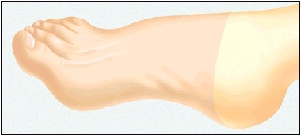What is Peripheral Neuropathy?
What is Peripheral Neuropathy?
Peripheral neuropathy is a disease of the nerves. It most often starts in your feet and may also eventually affect the arms. It can affect sensory, motor, or both functions. It may cause pain or make you unable to sense pain. Sometimes, weakness occurs as well. Lack of pain and weakness makes you more likely to injure yourself without knowing it. But you can learn ways to protect your feet from injury.
When nerves are diseased
Nerves in your feet carry signals to your brain. Your brain reads those signals and interprets them as sensations. When nerves in your feet are diseased, signals may be disrupted or changed. The result may be a lack of feeling (numbness) in your feet or other symptoms, such as tingling or pain.
Symptoms mask pain
Symptoms of peripheral neuropathy usually start in your toes. The symptoms slowly spread up your feet and legs as more nerve is affected. These symptoms may decrease sensation in your feet or mask pain. Without pain, you may not notice a cut or even a bone fracture. Cuts may become infected. Fractures may heal poorly and lead to foot deformity.
Common causes of peripheral neuropathy
Some common causes of peripheral neuropathy include:
Diabetes or other endocrine disorders
Toxins (such as alcohol)
Nutritional deficiencies (such as Vitamin B-12)
Kidney disease
Injury
Repetitive stress (such as carpal tunnel syndrome)
Autoimmune disease
Cancer and tumors
Chemotherapy cancer treatment
Arthritis
Advanced age
Neurological disorders
Infection
Diagnosis and treatment
Diagnosis of peripheral neuropathy includes a complete history and physical exam. Tests include blood tests and imaging often help find the cause. Special nerve tests are often helpful including nerve conduction velocity studies (NCV), and electromyography (EMG). NCV helps find evidence of poor conduction of nerve signals. EMG helps tell whether symptoms are caused by muscle or nerve disorders.
Treatment focuses on treating the underlying disorder and treating the symptoms using medicines, injections, TENS (transcutaneous electrical nerve stimulation), acupuncture, massage, and others.
Updated:
January 01, 2018
Sources:
England, JD, Distal Symmetric Polyneuropathy: A Definition for Clinical Research, Neurology (2005); 64; pp. 199-207
Reviewed By:
Sather, Rita, RN,Shelat, Amit, MD
